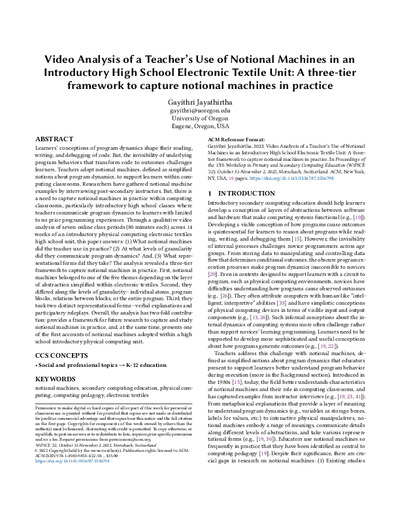Video Analysis of a Teacher's Use of Notional Machines in an Introductory High School Electronic Textile UnitA three-tier framework to capture notional machines in practice
Gayithri Jayathirtha
Publikationsdatum:
Zu finden in: WiPSCE '22, 2022
 |
 |
 Diese Seite wurde seit 3 Jahren inhaltlich nicht mehr aktualisiert.
Unter Umständen ist sie nicht mehr aktuell.
Diese Seite wurde seit 3 Jahren inhaltlich nicht mehr aktualisiert.
Unter Umständen ist sie nicht mehr aktuell.
 Zusammenfassungen
Zusammenfassungen

Learners’ conceptions of program dynamics shape their reading, writing, and debugging of code. But, the invisibility of underlying program behaviors that transform code to outcomes challenges learners. Teachers adopt notional machines, defined as simplified notions about program dynamics, to support learners within computing classrooms. Researchers have gathered notional machine examples by interviewing post-secondary instructors. But, there is a need to capture notional machines in practice within computing classrooms, particularly introductory high school classes where teachers communicate program dynamics to learners with limited to no prior programming experiences. Through a qualitative video analysis of seven online class periods (80 minutes each) across 14 weeks of an introductory physical computing electronic textiles high school unit, this paper answers: (1) What notional machines did the teacher use in practice? (2) At what levels of granularity did they communicate program dynamics? And, (3) What representational forms did they take? The analysis revealed a three-tier framework to capture notional machines in practice. First, notional machines belonged to one of the five themes depending on the layer of abstraction simplified within electronic textiles. Second, they differed along the levels of granularity—individual atoms, program blocks, relations between blocks, or the entire program. Third, they took two distinct representational forms—verbal explanations and participatory roleplays. Overall, the analysis has two-fold contribution: provides a framework for future research to capture and study notional machines in practice, and, at the same time, presents one of the first accounts of notional machines adopted within a high school introductory physical computing unit.
 Dieses Konferenz-Paper erwähnt ...
Dieses Konferenz-Paper erwähnt ...
 Personen KB IB clear | Michael Berry , Kayla DesPortes , Betsy DiSalvo , Benedict du Boulay , Sally Fincher , Kathi Fisler , Michael Kölling , Shriram Krishnamurthi , Colleen M. Lewis , Emily MacLeod , John Monk , Tim O'Shea , Seymour Papert , Anthony V. Robins , Sue Sentance , Jane Waite , Lucy Yeomans | ||||||||||||||||||||||||||||||||||||||||||||||||||||||||||||||||||||||||
 Begriffe KB IB clear | Informatik-Unterricht (Fachinformatik)Computer Science Education
, Informatikunterricht in der Schule
,  LehrerIn LehrerIn teacher
, notional machine
, physical computing
, teacher
, notional machine
, physical computing
,  Programmieren Programmieren programming
, programming
,  Schule Schule school
, school
,  Unterricht Unterricht
| ||||||||||||||||||||||||||||||||||||||||||||||||||||||||||||||||||||||||
 Bücher |
| ||||||||||||||||||||||||||||||||||||||||||||||||||||||||||||||||||||||||
 Texte |
|
 Dieses Konferenz-Paper erwähnt vermutlich nicht ...
Dieses Konferenz-Paper erwähnt vermutlich nicht ... 
 Nicht erwähnte Begriffe | Bildung, Digitalisierung, Informatik, Informatik-Didaktik, Kinder, Lernen, Primarschule (1-6) / Grundschule (1-4), Schweiz |
 Tagcloud
Tagcloud
 Zitationsgraph
Zitationsgraph
 Zitationsgraph (Beta-Test mit vis.js)
Zitationsgraph (Beta-Test mit vis.js)
 Zeitleiste
Zeitleiste
 Anderswo finden
Anderswo finden
 Volltext dieses Dokuments
Volltext dieses Dokuments
 |  Video Analysis of a Teacher's Use of Notional Machines in an Introductory High School Electronic Textile Unit: Fulltext at the ACM Digital Library ( Video Analysis of a Teacher's Use of Notional Machines in an Introductory High School Electronic Textile Unit: Fulltext at the ACM Digital Library ( : :  , 1662 kByte; , 1662 kByte;  : :  ) ) |
 Anderswo suchen
Anderswo suchen 
 Beat und dieses Konferenz-Paper
Beat und dieses Konferenz-Paper
Beat hat Dieses Konferenz-Paper während seiner Zeit am Institut für Medien und Schule (IMS) ins Biblionetz aufgenommen. Beat besitzt kein physisches, aber ein digitales Exemplar. Eine digitale Version ist auf dem Internet verfügbar (s.o.). Es gibt bisher nur wenige Objekte im Biblionetz, die dieses Werk zitieren.


















 Biblionetz-History
Biblionetz-History